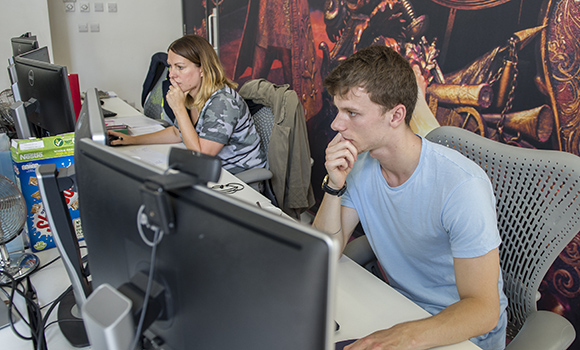
(Photo Credit: InstituteForApprenticeships/Flickr)
Just out of my high school vocational program, I began my career as an auto mechanic at 17 years old. My father before me had graduated from college and retired after working a white-collar career at Lockheed for 30 years. Times had already changed by the late-1980s, and, while I thought I had it all figured out, I was pretty sure most people my age wouldn’t settle at a single employer for the span of our career life.
Rather than burn my father’s retirement proceeds failing at college—and much to his chagrin—I forged my own path in a blue-collar trade. This was in the pre-internet days, and although I considered myself reasonably smart, I just didn’t see a pathway into anything else that provided purpose. Fixing cars was something I was good at, paid a decent salary in the teen era of Silicon Valley, and gave me the validation and instant gratification I needed as a young man leaving the nest.
In the automotive trade, car dealerships provided the coveted job positions in which you enrolled into an apprenticeship program, which involved on the job training along with concurrent education at the local community college. I was mentored by journeyman auto mechanics 15-20 years my senior, and developed lifelong relationships with my mentors and peers whom I greatly respected.
I learned what it was to be an independent young adult with a strong work and moral ethic and the gift of being able to help those less fortunate than myself (everyone has car problems, but not always the financial ability to maintain a car). Through the economic swing of the 1990s, I also learned what is was like to be a freelancer, fixing cars out of my garage to make ends meet during economic down cycles.
In the mid-1990s I learned of the internet and began to experiment with technology using a hand-me-down Mac from my generous and inspiring stepmother. She would also serve as a mentor having worked with computer technology in her career. With her guidance, I decided to take a couple of night classes in computer science at the local community college. The timing ended up being perfect with the dot-com era in full swing and a quickly growing new technology sector began to suffer from a lack of qualified talent.
Gone were the requirements of a college degree and for a brief period you could get a tech job if you were capable. Although technically a high school dropout, I was fortunate enough to have a transferable skill-set from my automotive career, and with a little training was able to establish myself as an IT technician.
After managing to get a foothold in the tech industry, surviving the dot-com crash, and after a long stint at a startup, I decided I wanted to pursue a third career as an entrepreneur. Leveraging 18 years of diverse career skills, I set out to build a consulting practice.
It became immediately apparent that finding good talent and growing the company was going to be a struggle. After a few years I discovered the internship program at the local community college, and I began to court potential interns with the only thing I had to barter with: knowledge. I would take them under my wing and teach them everything I know and, in exchange, I would try to create an employment position for them.
This mutually beneficial arrangement ended up working, and over the course of the following eight-plus years we have run 41 internships and hired 17 of those interns as employees. As we share a mutual interest in learning and exploring technology, we form lasting relationships, and accomplish great things together while growing the company.
Enter the Silicon Valley tech boom of the 2010s. Just like I struggled to find talent in the beginning of our company, there are many more jobs available than qualified people to fill them. While we experienced a four-year average churn rate on our intern hires, our direct hires were moving on at a faster rate. The reasons varied from geography, to career change, to seeking other opportunities of growth and/or wealth.
While this was initially depressing, I learned it was simply the lifecycle of a mentorship and we weren’t yet big enough to provide the opportunities for advancement some of our employees were looking for. While I could have taken this as a failure and rejoined the workforce, instead I accepted this situation and embraced it as an opportunity.
Things had come full circle. Further nurturing our relationship with Cabrillo Community College, we partnered in the first-of-its-kind tech apprenticeship in Santa Cruz County. We created an apprenticeship as part of a three-year IT program which would enable community college students to explore and pursue a career in tech.
Just like the internships before them, we knew that investing in our apprentices would result in a return of loyalty as well as a commitment to excellence, the very product we sell to our customers. The motivation to go this direction was far beyond filling seats at the company. We saw willing and able people in the community who would be left behind—gentrified out of their homes by the technology boom, which was allowing us to grow.
Diverging slightly from the mentorship model of traditional workforce training programs, we see a modern tech apprenticeship as part boot camp, in which immersive curriculum is delivered to the apprentices in the workplace over a longer more digestible time period. This approach serves to fill the widening skills gap, the result of an education system which has been solely focused on theoretical learning, rather than vocational training on real world use cases, solving real world problems.
The stakes in this game are also high, and with technology continuing to outpace the education system, there is no room for mediocrity. We aren’t training people to be entry level. We are training them to be rock stars.
 During my lifetime as a member of Generation X, I have had to reinvent myself several times and I continue to build my professional skill-set and evolve so I am not left behind. Subsequent generations are not excluded—this is the new normal. During my career I’ve seen companies deal with skills shortages in a variety of ways, including work visas, outsourcing, and offshoring—strategies which have proven necessary and also underpin the importance of effective education and training for everyone.
During my lifetime as a member of Generation X, I have had to reinvent myself several times and I continue to build my professional skill-set and evolve so I am not left behind. Subsequent generations are not excluded—this is the new normal. During my career I’ve seen companies deal with skills shortages in a variety of ways, including work visas, outsourcing, and offshoring—strategies which have proven necessary and also underpin the importance of effective education and training for everyone.
With the demand for a skilled workforce continuing to increase, we have reached a point in which industry (particularly tech) must move off the sidelines and take an ownership role in educating our citizens. Without participation from industry, the education system cannot meet the constantly changing requirements for a skilled workforce. This is a difficult but necessary step for our society to remain self sufficient and sustainable.
Chris Miller is the founder of Apprentice Brigade, an organizational unit which curates quality talent for its sister divisions, Cloud Brigade and Launch Brigade. Apprentice Brigade aims to build talent for other companies in the Central Coast community.

